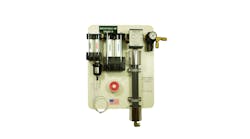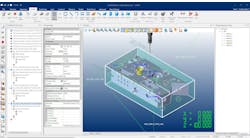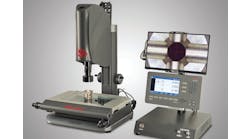Latest from Testing/QC
Good Luck and Good ‘Nite
Arc Flash-Rated Height Safety
Breathable-Air Combo System
Updated CMM Software
FM&T's 2024 Guide to Exhibitors
Manual Video Measurement, Inspection
All the fortunes of metalcasting companies depend on a series of thermal and chemical reactions that are not quite as predictable as the operators may wish. What happens within a furnace is critically important to the molten metal that comes out of it – and to the companies operating those vessels. And yet, quite a lot of what is known about that activity is assumed from theoretical assumptions, or experience. That may begin to change.
Based on a newly defined spectrographic system, the chemical composition and temperature of molten steel are being monitored in real-time in basic oxygen furnaces at Tata Steel UK’s Port Talbot Works, in Wales. This capability will achieve a new baseline for steelmaking productivity there, according to the process developers, who predict average production-cost savings of almost $6 million/year (£4.5 million) per plant.
The current practice for monitoring thermal and chemical reactions involves pausing activities and inserting a disposable probe into the molten-metal bath through a furnace tuyere, to measure the bath temperature and collect a metal sample. There is some safety risk in this, as well as material cost for the probe device. It is time-consuming too, leading naturally to productivity loss.
“We have been able to adapt and combine recent advances in refractory manufacturing and laser metrology to enable continuous monitoring with no break in production,” explained the developer, Dr. Szymon Kubal, a process technology specialist for Tata Steel and research fellow at Swansea University. “Our new technology allows a laser beam to be projected into a molten furnace through a refractory gas-swept channel (i.e., the tuyere) in the furnace wall. And, we are now able to exploit the latest gas-injection techniques to protect the data channel.”
In addition to Kubal, the team includes metallurgist Dr. Cameron Pleydell-Pearce, a co-director of the Advanced Imaging of Materials Centre at Swansea University; and Dr. Adrian Walters, a commercialization expert.
“Previous attempts of laser-measurement techniques have been thwarted because metallic accretions block the channel through which the laser is probing, rendering the devices unreliable,” Kubal noted. “This innovation does do not suffer from such problems; it relies on a novel, ‘all-refractory’ tuyere design that is the subject of a patent owned by Swansea University, to which Kubal-Wraith has exclusive exploitation rights.”
Kubal-Wraith Ltd. was formed by the process developers for that purpose. Their efforts and the promise of their innovation earned them Materials Science Venture Prize awarded by The Worshipful Company of Armourers and Brasiers — an industrial guild that supports technological and economic opportunities for metal-producing businesses.
Steelmaking operations have been the first targets for this new technology, but there are various other process- and cost-saving possibilities for evaluating the application in industrial-scale molten-metal production, such as in foundries, diecasters, and secondary aluminum melting and refining.
“A critical barrier for us to overcome was the extreme difficulty in getting permission to test our new innovations in an operational steel plant under production conditions,” Kubal stated. “However, by working in collaboration with Tata Steel UK we are able to undertake full-scale validation trials.”
“This project shows how research and innovation has the potential to transform long-established manufacturing processes,” said Prof. Bill Bonfield, chairman of the Armourers and Brasiers Venture Prize judging panel. “Our prize looks to encourage scientific entrepreneurship in the U.K., and provide funding to help innovative developments like this realize their potential.”









